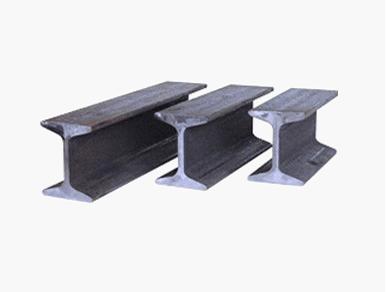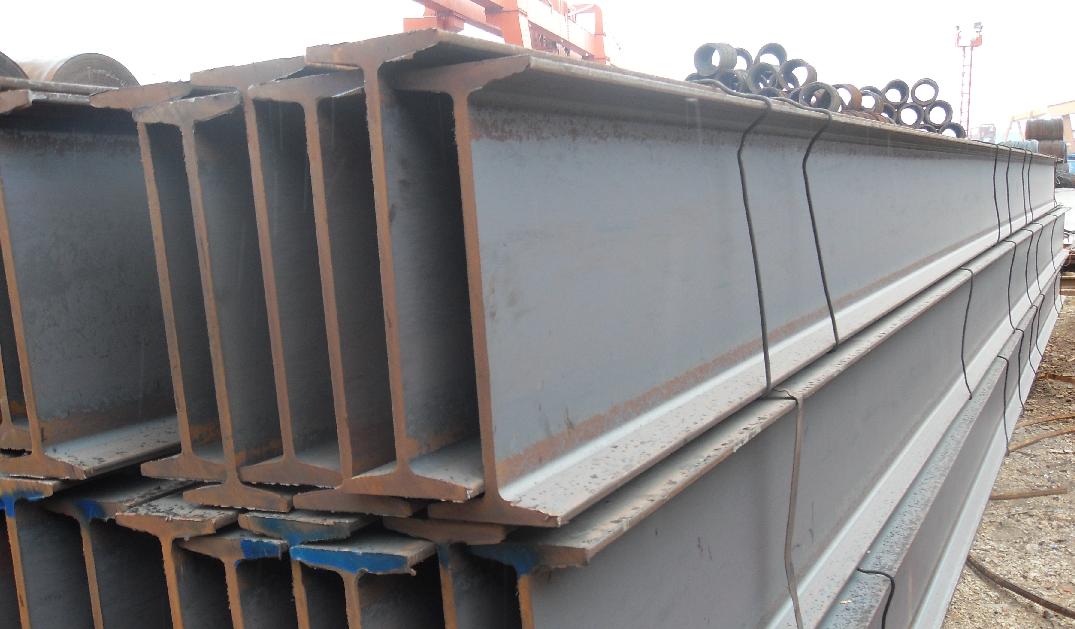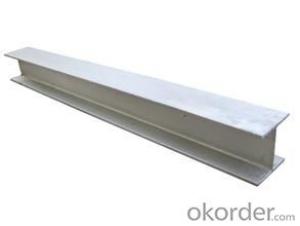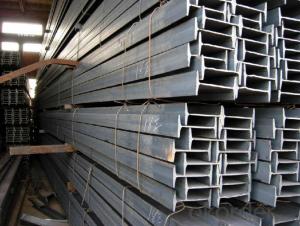Painted or Galvanized Steel I Beam,The Largest Supplier of China
- Loading Port:
- Qingdao
- Payment Terms:
- TT OR LC
- Min Order Qty:
- 3000 PCS
- Supply Capability:
- 400000 PCS/month
OKorder Service Pledge
OKorder Financial Service
You Might Also Like
Detail information of Steel I Beam
Product Name | High Quality Steel I Beam |
Height: | 100-400mm |
Thickness: | 4.5-14.5mm |
Surface: | Painted or Galvanized. As customers’ requirements |
Length: | As customers’ requirements |
Size: | 100*68*4.4mm--400*146*14.5mm . |
Punch: | Can be punched as customer's drawing |
Material: | Q195/Q235/ Q215/Q345/SS400/S235JR, A36,SS400,SS540 ASTM A36 |
Product Advantage
Prime quality
Competitive price
Professional service
Prompt delivery & Seaworthy packing
Mill Test Certificate
Product Picture



Company Information
Our company is one of the largest manufacturing bases of Steel Channel in northern China. We are a company that is specialized in producing Stainless Steel Channel、Prime Stainless Steel Channels and so on.
With years of development, our company won the trust and excellen reputation of customers for the quality of our products and sincere service, as well as foreign users of the community.
Please contact me if you are interested in our products and I will try my best to offer you the best goods and service.
Packaging & Delivery
Packaging Detail:according to the customer's request
Delivery Detail:15-20 days after received the deposite
FAQ
(1) How is the quality of your products?
Our products are manufactured strictly according to national and international standard, and we take a test on every product before delivered out. If you want to see our quality certifications and all kinds of testing report, please just ask us for it.
(2) Guaranteed:
If products' quality doesn’t match the description we give or promise before you place your order, we promise 100% refund.
(3) How about price?
Yes, we are factory and be able to give you lowest price below market one, and we have a policy that " for saving time and absolutely honest business attitude, we quote as lowest as possible for any customer, and discount can be given according to quantity”, if you like bargain and factory price is not low enough as you think, just don't waste your time.
Please trust the quotation we would give you, it is professional one.
(4) Why should you choose us?
Chose happens because of quality, then price, we can give you both. Additionally, we can also offer professional products inquiry, products knowledge train (for agents), Quick goods delivery, our factories locate near the seaport, which is very convenient for transportation.
Our service formula: good quality+good price+good service=customer's trust
Steel I Beam Specification Table
Model | Size(mm) | Cross Sectional Area(cm2) | Theoretical Weight(kg/m) | ||
Height | Width | Thickness | |||
10 | 100 | 68 | 4.5 | 14.3 | 11.2 |
12 | 120 | 74 | 5.0 | 17.8 | 14.0 |
14 | 140 | 80 | 5.5 | 21.5 | 16.9 |
16 | 160 | 88 | 6.0 | 26.1 | 20.5 |
18 | 180 | 94 | 6.5 | 30.6 | 24.1 |
20A | 200 | 100 | 7.0 | 35.5 | 27.9 |
20B | 200 | 102 | 9.0 | 39.5 | 31.1 |
22A | 220 | 110 | 7.5 | 42.0 | 33.0 |
22B | 220 | 112 | 9.5 | 46.4 | 36.4 |
24A | 240 | 116 | 8.0 | 47.7 | 37.4 |
24B | 240 | 118 | 10.0 | 52.6 | 41.2 |
27A | 270 | 122 | 8.5 | 54.6 | 42.8 |
27B | 270 | 124 | 10.5 | 60.0 | 47.1 |
30A | 300 | 126 | 9.0 | 61.2 | 48.0 |
30B | 300 | 128 | 11.0 | 67.2 | 52.7 |
30C | 300 | 130 | 13.0 | 73.4 | 57.4 |
36A | 360 | 136 | 10.0 | 76.3 | 59.9 |
36B | 360 | 138 | 12.0 | 83.5 | 65.6 |
36C | 360 | 140 | 14.0 | 90.7 | 71.2 |
40A | 400 | 142 | 10.5 | 86.1 | 67.6 |
40B | 400 | 144 | 12.5 | 94.1 | 73.8 |
40C | 400 | 146 | 14.5 | 102 | 80.1 |
- Q:What are the different types of steel I-beam profiles?
- In construction and engineering projects, a variety of steel I-beam profiles are commonly utilized. Some of the frequently encountered profiles are as follows: 1. W shape: This particular I-beam profile is widely employed due to its wide flanges and straight web. It offers exceptional strength and stability, making it suitable for a broad range of applications. 2. S shape: The S shape I-beam exhibits tapered flanges and a thinner web in comparison to the W shape. It is often employed in scenarios where lighter weight and flexibility are necessary, such as architectural and aesthetic applications. 3. HP shape: The HP shape I-beam, standing for "H-pile," is primarily used in deep foundation applications. Its distinguishing features include wide flanges and a thick web, providing remarkable load-bearing capacity in situations where high strength and stability are critical. 4. M shape: The M shape I-beam, also referred to as a "miscellaneous" shape, is less commonly encountered and typically utilized for specialized applications. It possesses unequal flanges and a thinner web, rendering it suitable for unique structural requirements. 5. L shape: The L shape I-beam, also known as angle iron, is characterized by its 90-degree angle and is commonly employed in smaller-scale structural applications, such as framing and support brackets. These examples represent a mere fraction of the diverse array of steel I-beam profiles that are available. The choice of profile depends on the specific project requirements, encompassing load-bearing capacity, size limitations, and aesthetic considerations.
- Q:Can steel I-beams be used in sports arenas or stadiums?
- Sports arenas and stadiums can indeed incorporate steel I-beams. In fact, they are frequently utilized in the construction of these expansive edifices owing to their robustness, longevity, and adaptability. Steel I-beams offer exceptional load-bearing capabilities, enabling them to bear heavy burdens and endure the forces generated during sporting events, such as vibrations, impacts, and dynamic loads. By employing steel I-beams in sports arenas and stadiums, the structural integrity of the facility is ensured, creating a secure environment for both spectators and athletes. Furthermore, the versatility of steel I-beams allows for flexible design options and efficient construction, rendering them a favored selection in the industry.
- Q:What are the different grades of steel used for manufacturing I-beams?
- There are several different grades of steel that are commonly used for manufacturing I-beams. These grades are designated by a combination of numbers and letters, which indicate the composition and properties of the steel. Some of the most commonly used grades for I-beams include: 1. ASTM A36: This is the most commonly used grade of steel for I-beams. It is a low carbon steel that offers good strength and formability. ASTM A36 steel is known for its excellent weldability and machinability, making it a popular choice for construction and structural applications. 2. ASTM A572: This grade of steel offers high strength and excellent corrosion resistance. It is commonly used for I-beams in heavy-duty construction projects, such as bridges and buildings. ASTM A572 steel is available in different grades, with the most commonly used being A572 Gr. 50. 3. ASTM A992: This grade of steel is specifically designed for I-beams and other structural shapes. It offers excellent strength and weldability, making it suitable for a wide range of applications. ASTM A992 steel is often used in building construction, as it provides a higher strength-to-weight ratio compared to other grades. 4. ASTM A709: This grade of steel is primarily used for I-beams in bridge construction. It offers high strength and good corrosion resistance, making it suitable for outdoor applications. ASTM A709 steel is available in different grades, with the most commonly used being Grade 50W. 5. ASTM A913: This grade of steel is specifically designed for high-strength I-beams. It offers excellent strength, weldability, and formability. ASTM A913 steel is commonly used in heavy-duty construction projects, such as skyscrapers and industrial buildings. It is important to note that the choice of steel grade for manufacturing I-beams depends on various factors, such as the required strength, load-bearing capacity, and environmental conditions. Consulting with a structural engineer or steel fabricator is recommended to determine the most suitable grade of steel for a specific application.
- Q:Are steel I-beams cost-effective compared to other structural options?
- Yes, steel I-beams are generally considered to be cost-effective compared to other structural options. They offer a high strength-to-weight ratio, which allows for efficient use of materials and reduced construction costs. Additionally, steel I-beams have excellent load-bearing capabilities, providing durability and long-term cost savings by minimizing the need for repairs or replacements.
- Q:How do steel I-beams perform in areas with high levels of UV radiation?
- Steel I-beams generally perform well in areas with high levels of UV radiation. UV radiation can cause damage and degradation to many materials, including wood, plastic, and some metals. However, steel is known for its durability and resistance to UV radiation. Steel is typically coated with protective layers to prevent corrosion and enhance its resistance to environmental factors, including UV radiation. These coatings, such as galvanization or paint, act as a barrier between the steel and the UV rays, preventing direct exposure and potential damage. Additionally, steel has a high melting point and is not easily affected by the heat generated by UV radiation. Furthermore, the structural design of I-beams adds to their ability to withstand UV radiation. The shape of the I-beam allows for efficient weight distribution and load-bearing capacity, making them less susceptible to warping or distortion due to UV exposure. That being said, prolonged exposure to intense UV radiation over many years can still have some impact on steel I-beams. The protective coatings may eventually wear off, exposing the steel to direct UV radiation, which can lead to some corrosion or surface degradation. However, proper maintenance, such as regular inspections, cleaning, and reapplication of protective coatings, can mitigate these effects and ensure the longevity of steel I-beams in high UV radiation areas. In summary, steel I-beams are generally well-suited for areas with high levels of UV radiation due to their inherent durability and resistance to UV damage. With proper maintenance and protective coatings, steel I-beams can effectively withstand the challenges posed by UV radiation, ensuring their structural integrity and longevity.
- Q:How do steel I-beams perform in high-traffic bridge applications?
- Due to their exceptional strength and durability, steel I-beams are an excellent option for high-traffic bridge applications. These beams are specifically engineered to withstand heavy loads and offer superior structural support, making them ideal for use in bridges experiencing high volumes of traffic. A key advantage of steel I-beams is their ability to carry heavy loads. They can withstand the weight of multiple vehicles simultaneously, ensuring the safety and stability of the bridge, even under extreme traffic conditions. Not only are steel I-beams strong, but they also possess long-term durability. They are highly resistant to corrosion, rust, and other environmental factors, enabling their use in various climates and locations. This durability ensures that the bridge remains structurally sound and can endure the wear and tear caused by continuous traffic flow. Moreover, the design of steel I-beams allows for efficient weight distribution, reducing the strain on the bridge structure. This efficient load distribution helps minimize deflection and deformation, guaranteeing the bridge's integrity over time. Another advantage of steel I-beams is their versatility in bridge construction. They can be easily fabricated and tailored to meet the specific requirements of each bridge project, including length, width, and height. This flexibility empowers engineers to design bridges that can accommodate different traffic conditions, ensuring optimal performance and safety. Overall, steel I-beams are a highly reliable and efficient choice for high-traffic bridge applications. Their strength, durability, and versatility make them the preferred option for engineers and architects when designing bridges capable of handling heavy traffic loads and providing long-lasting performance.
- Q:Can steel I-beams be customized for specific projects?
- Yes, steel I-beams can be customized for specific projects. Steel I-beams are versatile structural elements commonly used in construction due to their strength and load-bearing capabilities. They can be customized in terms of size, shape, and material specifications to suit the unique requirements of a project. Customization of steel I-beams can include altering their dimensions such as length, width, and depth to meet the specific load and span requirements of a structure. This allows engineers and architects to design structures with optimal functionality and safety. Moreover, steel I-beams can be fabricated from various types of steel, including carbon steel, stainless steel, or alloy steel, depending on the project's needs. This enables the customization of the beams to ensure compatibility with the surrounding environment, such as resistance to corrosion in coastal areas or increased strength for heavy industrial applications. Additionally, customization can involve the inclusion of specific features like holes, notches, or cut-outs in the I-beams to facilitate connections with other structural components, accommodate utility conduits, or allow for easy installation. In conclusion, steel I-beams can indeed be customized for specific projects. The ability to tailor their dimensions, material composition, and additional features allows for the creation of structurally sound and efficient designs that meet the unique requirements of any construction project.
- Q:Are there any limitations to the length of steel I-beams?
- Yes, there are limitations to the length of steel I-beams. The length of steel I-beams is limited by various factors, including manufacturing capabilities, transportation logistics, and structural considerations. In terms of manufacturing capabilities, the size and length of steel I-beams that can be produced are limited by the capacity of the steel mills and fabrication facilities. These facilities have specific equipment and processes in place, which may restrict the maximum length that can be produced efficiently and cost-effectively. Transportation logistics also play a crucial role in limiting the length of steel I-beams. Due to their size and weight, longer beams may be challenging to transport from the manufacturing facility to the construction site. Factors such as road and bridge weight restrictions, transportation infrastructure limitations, and the availability of specialized equipment for handling and transporting long beams can further restrict their length. Structural considerations are another important limitation. The longer the steel I-beam, the greater the risk of deflection or bending under load. Beyond a certain length, the beam's structural integrity may be compromised, leading to potential safety concerns. Structural engineers and architects must carefully analyze the load-bearing requirements of a particular project and determine the maximum allowable length for steel I-beams based on factors such as load distribution, beam design, and support systems. In summary, while steel I-beams can be manufactured in various lengths, there are limitations imposed by manufacturing capabilities, transportation logistics, and structural considerations. It is essential to work with professionals in the industry to ensure that the length of steel I-beams used in construction projects adheres to these limitations while meeting the required design standards and safety regulations.
- Q:What are the different types of steel I-beam connections for roof framing?
- Roof framing for steel I-beams involves various types of connections, each with its own advantages and applications. 1. One common and straightforward method is the welded connection. By welding the ends of the beams together, a strong and rigid connection is created. Welded connections are often used for heavy loads and situations where structural stability is crucial. 2. Another method is the bolted connection, where steel plates or angles are bolted to the flanges of the I-beams. This allows for easy disassembly if needed and can accommodate different beam sizes and angles, making it suitable for various roof framing designs. 3. A gusset plate connection involves welding or bolting a steel plate to the webs of two I-beams, effectively joining them together. This type of connection is commonly used in roof framing to transfer loads and provide additional strength and stability, especially in situations where load-bearing capacity and resistance against lateral forces are needed. 4. For the transfer of bending moments between two beams, a moment connection is used. This more complex type of connection involves welding or bolting additional steel plates and angles to the flanges and webs of the I-beams. Moment connections are typically used in large-span roof structures or where there is a need to resist lateral and vertical loads. 5. Cleat connections are made by attaching steel plates, called cleats, to the flanges of two I-beams using bolts or welding. This type of connection is commonly used when beams need to be joined at an angle or connected to other structural elements such as columns or walls. Cleat connections offer flexibility in design and ease of installation. When selecting the appropriate type of steel I-beam connection for roof framing, it is important to consider factors such as load requirements, structural stability, and ease of assembly. Consulting with a structural engineer or a roofing professional can help determine the most suitable connection method for a specific project.
- Q:Are Steel I-Beams fire resistant?
- Yes, steel I-beams are generally considered to be fire resistant due to their high melting point and ability to retain their structural integrity even under extreme heat.
1. Manufacturer Overview |
|
|---|---|
| Location | |
| Year Established | |
| Annual Output Value | |
| Main Markets | |
| Company Certifications | |
2. Manufacturer Certificates |
|
|---|---|
| a) Certification Name | |
| Range | |
| Reference | |
| Validity Period | |
3. Manufacturer Capability |
|
|---|---|
| a)Trade Capacity | |
| Nearest Port | |
| Export Percentage | |
| No.of Employees in Trade Department | |
| Language Spoken: | |
| b)Factory Information | |
| Factory Size: | |
| No. of Production Lines | |
| Contract Manufacturing | |
| Product Price Range | |
Send your message to us
Painted or Galvanized Steel I Beam,The Largest Supplier of China
- Loading Port:
- Qingdao
- Payment Terms:
- TT OR LC
- Min Order Qty:
- 3000 PCS
- Supply Capability:
- 400000 PCS/month
OKorder Service Pledge
OKorder Financial Service
Similar products
New products
Hot products
Hot Searches
Related keywords
































